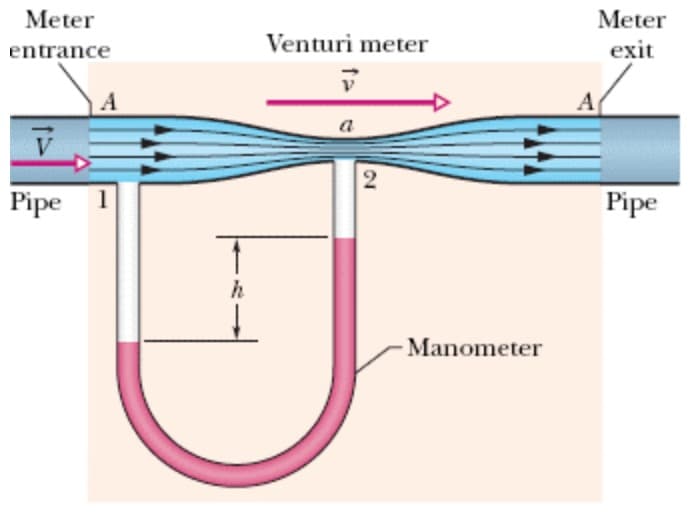A venturi meter is used to measure the flow speed of a fluid in a pipe. The meter is connected between two sections of the pipe (the figure); the cross-sectional area A of the entrance and exit of the meter matches the pipe's cross-sectional area. Between the entrance and exit, the fluid flows from the pipe with speed V and then through a narrow ''throat'' of cross-sectional area a with speed v. A manometer connects the wider portion of the meter to the narrower portion. The change in the fluid's speed is accompanied by a change Δp in the fluid's pressure, which causes a height difference h of the liquid in the two arms of the manometer. (Here Δp means pressure in the throat minus pressure in the pipe.) Let A equal 5·a. Suppose the pressure p1 at A is 2.1 atm. Compute the values of (a) the speed V at A and (b) the speed v at a that make the pressure p2 at a equal to zero. (c) Compute the corresponding volume flow rate if the diameter at A is 4.0 cm.The phenomenon that occurs at a when p2 falls to nearly zero is known as cavitation. Please assume that the fluid is water. The water vaporizes into small bubbles.
A venturi meter is used to measure the flow speed of a fluid in a pipe. The meter is connected between two sections of the pipe (the figure); the cross-sectional area A of the entrance and exit of the meter matches the pipe's cross-sectional area. Between the entrance and exit, the fluid flows from the pipe with speed V and then through a narrow ''throat'' of cross-sectional area a with speed v. A manometer connects the wider portion of the meter to the narrower portion. The change in the fluid's speed is accompanied by a change Δp in the fluid's pressure, which causes a height difference h of the liquid in the two arms of the manometer. (Here Δp means pressure in the throat minus pressure in the pipe.) Let A equal 5·a. Suppose the pressure p1 at A is 2.1 atm.
Compute the values of (a) the speed V at A and (b) the speed v at a that make the pressure p2 at a equal to zero.
(c) Compute the corresponding volume flow rate if the diameter at A is 4.0 cm.The phenomenon that occurs at a when p2 falls to nearly zero is known as cavitation. Please assume that the fluid is water. The water vaporizes into small bubbles.

Trending now
This is a popular solution!
Step by step
Solved in 3 steps









